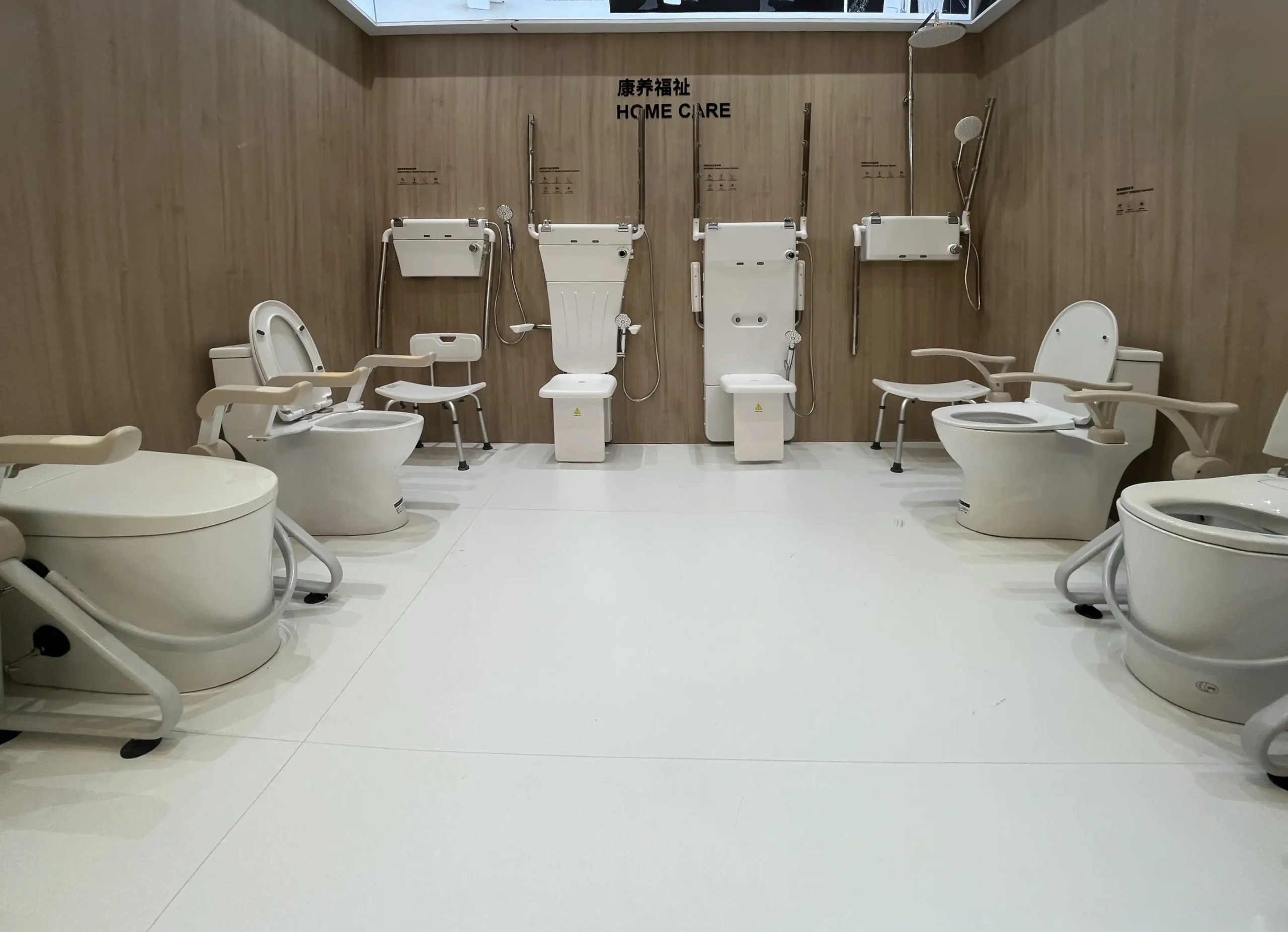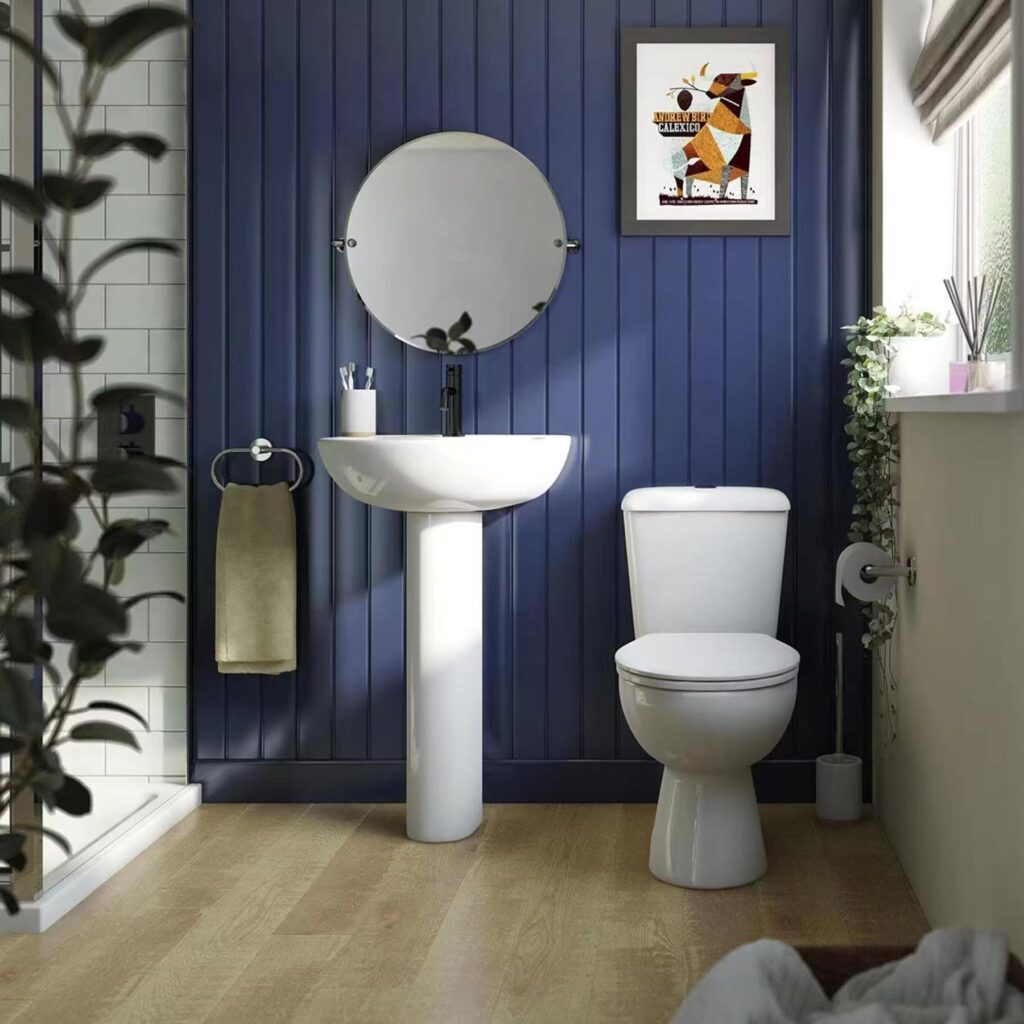Giới thiệu
For architects and facility managers, the rising demand for accessible spaces isn’t just a trend—it’s a critical necessity backed by strict regulations. With public procurement increasingly prioritizing inclusivity, understanding the distinction between disabled and standard toilets has become a **”must-know”** for any serious project planning.
The challenges go beyond simple measurements. While standard toilets focus on general functionality, disabled toilets must meet specific ADA requirements, from precise turning radiuses to strategically placed support features. These differences impact everything from initial design phases to final compliance checks, directly affecting project timelines and budgets.
Drawing from extensive experience in ceramic sanitary ware manufacturing, we’ve identified the key design, regulatory, and usability distinctions that matter most. This comprehensive guide breaks down the essential differences between disabled and standard toilets, ensuring your projects meet both legal requirements and user needs effectively.
Introduction to Disabled and Standard Toilets
The evolution of bathroom design has significantly shifted toward creating more inclusive spaces that cater to diverse user needs. As a “game-changing” development in public facilities, the disabled toilet has become an essential feature that goes beyond basic functionality to ensure accessibility for all.
Disabled toilets are specially designed facilities that provide enhanced accessibility and safety features, making them fundamentally different from standard toilets in terms of space, layout, and supporting equipment.
A disabled toilet incorporates specific design elements that distinguish it from standard facilities. These accessible toilets feature wider doorways, increased floor space for wheelchair maneuverability, and strategically placed grab bars. The growing emphasis on inclusive bathroom design reflects our evolving understanding of accessibility needs.
Key Design Principles and Considerations
| Tính năng | Standard Toilet | Disabled Toilet | Regulatory Requirement | User Impact |
|---|---|---|---|---|
| Door Width | 24-32 inches | 32-36 inches | ADA Compliant | Wheelchair Access |
| Floor Space | 15-18 sq ft | 30-35 sq ft | Required by Law | Turning Radius |
| Grab Bar Load | Not Required | 250 lbs minimum | Safety Standard | Transfer Support |
| Toilet Height | 14-15 inches | 17-19 inches | Comfort Height | Easier Transfer |
| Clear Floor Space | 21 inches front | 48 inches front | Accessibility Code | Mobility Aid Use |
Standard toilets, while functional for most users, follow conventional designs focused on general use. They typically occupy less space and have fewer specialized features. However, the increasing awareness of accessibility needs has led to a transformation in how we approach bathroom design.
The importance of disabled toilets extends beyond compliance with regulations. These facilities play a crucial role in promoting dignity and independence for users with mobility challenges. Public spaces and commercial establishments are increasingly recognizing the value of inclusive design in meeting diverse user needs.
Recent trends in facility management show a growing demand for accessible toilet installations. This shift reflects both regulatory requirements and a broader understanding of social responsibility. Modern disabled toilets incorporate advanced features while maintaining ease of maintenance and durability.
As we explore the differences between disabled and standard toilets, it’s essential to understand how local regulations shape design requirements. Different regions may have varying specifications, though all share the common goal of ensuring accessibility and safety for users with disabilities.

Key Design Differences Between Disabled and Standard Toilets
When it comes to bathroom design, the differences between disabled toilets and standard facilities are far more than just “nuts and bolts” – they represent fundamental shifts in accessibility and functionality. Understanding these crucial distinctions helps create truly inclusive spaces that serve all users effectively.
The key design differences between disabled and standard toilets encompass specific dimensional requirements, safety features, and accessibility elements that ensure comfortable use for people with mobility challenges.
Dimensional Requirements and Space Allocation
| Design Element | Standard Toilet | Disabled Toilet | Purpose | Compliance Standard |
|---|---|---|---|---|
| Room Dimensions | 3ft x 5ft typical | 1.5m x 1.5m minimum | Wheelchair Turning | ADA/BS8300 |
| Door Clearance | 24 inches | 34 inches minimum | Access Width | Universal Design |
| Transfer Space | None specified | 750mm either side | Lateral Transfer | ISO 21542 |
| Basin Height | 31-33 inches | 28-34 inches adjustable | Reach Range | EN 997 |
| Emergency Alarm | Not Required | Two-Way System | Safety Protocol | DIN 18040 |
The disabled toilet design incorporates specific spatial requirements that significantly differ from standard installations. These dimensions ensure adequate room for wheelchair maneuverability and caregiver assistance when needed. The minimum space requirement of 1.5m x 1.5m provides essential turning radius for wheelchair users.
Key accessibility features in disabled toilets include strategically positioned grab bars that can support up to 250 pounds of weight. The toilet height is typically set between 17-19 inches, compared to the standard 14-15 inches, facilitating easier transfers from wheelchairs. Door widths are also notably different, with disabled toilets requiring wider clearances.
Standard toilet layouts prioritize space efficiency and typically occupy minimal floor area. These designs focus on basic functionality without additional support features. However, the compact nature of standard toilets may limit their usability for people with mobility challenges.
The impact of these design differences extends beyond mere measurements. Proper implementation of disabled toilet specifications ensures user safety and independence. Additionally, incorporating these design elements early in the planning phase can help optimize project costs and timelines.
When selecting fixtures for accessible bathrooms, it’s crucial to consider both regulatory requirements and practical functionality. Modern disabled toilet designs balance aesthetic appeal with essential accessibility features, creating spaces that are both functional and welcoming.

Regulatory Standards and Compliance for Disabled Toilets
When it comes to accessibility regulations, keeping up with standards is no “walk in the park” – it requires careful attention to detail and comprehensive understanding. The regulations governing disabled toilets vary significantly across regions, with each jurisdiction maintaining specific requirements for public and commercial spaces.
Compliance with disabled toilet regulations is not optional – it’s a legal requirement that ensures equal access and dignity for all users while protecting facility owners from potential liability issues.
Global Regulatory Framework Overview
| Regulation Element | USA (ADA) | UK (BS8300) | EU (EN 997) | Implementation Timeline |
|---|---|---|---|---|
| Minimum Door Width | 32 inches | 900mm | 850mm | Immediate |
| Turning Circle | 60 inches | 1500mm | 1500mm | No Grace Period |
| Grab Bar Height | 33-36 inches | 680-700mm | 750mm | Upon Installation |
| Emergency Alarm | Optional | Mandatory | Required | Varies by Region |
| Compliance Checks | Annual | Bi-annual | Annual | Ongoing |
In the United States, the Americans with Disabilities Act (ADA) provides comprehensive guidelines for bathroom for disabled individuals. These specifications cover everything from turning spaces to fixture heights, ensuring universal accessibility in public facilities.
The UK and Ireland follow BS8300 standards, which differ slightly from ADA requirements. These variations include specific measurements for grab bar positions and emergency alarm systems. Understanding these regional differences is crucial for international project compliance.
Standard toilets have fewer regulatory mandates compared to their accessible counterparts. While building codes govern basic installation requirements, the specifications are less stringent. This contrast highlights the importance of specialized design in ADA compliant toilet facilities.
Non-compliance can result in significant consequences, including hefty fines and mandatory facility modifications. Beyond legal implications, failing to meet accessibility standards can damage reputation and limit facility usability for all patrons.
Facility managers must regularly review and update their installations to maintain compliance with evolving standards. This proactive approach helps ensure continuous accessibility while avoiding potential legal issues and renovation costs.

Usability and User Experience: Disabled vs. Standard Toilets
When it comes to bathroom accessibility, having the right facilities isn’t just “smooth sailing” – it’s essential for ensuring dignity and independence for all users. The user experience differences between disabled toilets and standard facilities highlight the crucial role of thoughtful design in meeting diverse needs.
The primary distinction in user experience between disabled and standard toilets lies in their purposeful design features, with accessible facilities incorporating multiple elements that enhance safety, comfort, and independence for users with mobility challenges.
User Experience Comparison Analysis
| Tính năng | User Impact | Disability Support | General Usage | Nhu cầu bảo trì |
|---|---|---|---|---|
| Emergency Systems | Critical Safety | Full Support | Not Available | Monthly Checks |
| Motion Sensors | Hands-free Operation | Enhanced Access | Limited | Quarterly Service |
| Support Rails | Transfer Assistance | Essential Aid | Not Required | Annual Inspection |
| Space Utilization | Mobility Freedom | Wheelchair Access | Compact Design | Regular Cleaning |
| Door Operation | Dễ dàng truy cập | Power Assisted | Manual Only | Bi-annual Check |
The accessible toilet experience begins with automated features that minimize physical effort. From sensor-activated flushing systems to hands-free taps, these elements create a more hygienic and user-friendly environment. Standard toilets, while functional, typically lack these specialized accessibility features.
Emergency response systems represent another crucial difference in user experience. Disabled toilets are equipped with alarm cords and two-way communication systems, providing essential safety features that standard facilities don’t include. This additional layer of security offers peace of mind for users and caregivers alike.
Space management within these facilities creates distinctly different user experiences. The generous dimensions of disabled toilets allow for comfortable wheelchair maneuverability and caregiver assistance when needed. Standard toilets prioritize spatial efficiency over accessibility, which can present significant challenges for users with mobility needs.
The implementation of universal design principles in inclusive bathroom spaces demonstrates how thoughtful planning can benefit all users. Features like adequate lighting, non-slip flooring, and clear signage enhance the experience for everyone, regardless of ability level.
Modern facility design increasingly recognizes that user experience extends beyond basic functionality. The trend toward inclusive design reflects a deeper understanding of diverse user needs and the importance of creating welcoming spaces for all visitors.

Practical Implementation: Choosing and Installing the Right Toilet Design
When it comes to selecting and installing the right toilet facilities, making it “chính xác” requires careful consideration of multiple factors. The decision-making process involves balancing regulatory compliance, budget constraints, and user needs to create truly functional spaces.
Successful implementation of toilet facilities depends on thorough planning, proper installation procedures, and careful consideration of both immediate and long-term maintenance requirements to ensure lasting accessibility and functionality.
Installation Requirements Comparison
| Implementation Factor | Standard Toilet | Disabled Toilet | Cost Impact | Maintenance Level |
|---|---|---|---|---|
| Installation Time | 4-6 hours | 8-12 hours | Trung bình | Standard |
| Plumbing Requirements | Nền tảng | Enhanced | Cao | Complex |
| Support Structure | Standard Wall Mount | Reinforced Mounting | Cao | Annual Check |
| Floor Preparation | Basic Leveling | Non-slip Surface | Trung bình | Quarterly |
| Electrical Points | None Required | Multiple Points | Cao | Bi-monthly |
The installation process for a disabled toilet requires special attention to structural support and precise measurements. Reinforced wall mounting systems must be implemented to support the additional weight-bearing requirements of grab bars and other accessibility features.
Plumbing considerations differ significantly between standard and accessible installations. Disabled bathroom design must account for specialized fixture heights and locations, often requiring modified waste pipe configurations and water supply positions. These adjustments ensure proper functionality while maintaining accessibility standards.
Budget planning should consider both immediate installation costs and long-term maintenance requirements. While standard toilets typically have lower initial costs, accessible facilities offer greater value through enhanced usability and compliance with regulatory requirements.
Recent trends in public procurement show increasing emphasis on universal design principles. Facility managers are moving beyond basic compliance to create truly inclusive spaces that anticipate diverse user needs while maintaining aesthetic appeal.
The key to successful implementation lies in careful planning and coordination among stakeholders. From initial design to final installation, each step must align with accessibility standards while considering practical maintenance and durability factors.

Phần kết luận
After exploring the nuances between disabled and standard toilets, it’s clear that accessibility isn’t just about meeting regulations—it’s about creating spaces that respect and empower every user. The substantial differences in design, from wider doorways to strategic grab bar placements, reflect a deeper understanding of diverse mobility needs.
Drawing from my years in sanitary ware manufacturing, I’ve seen how thoughtful bathroom design can be a **”người thay đổi trò chơi”** for facility accessibility. Whether you’re planning a new installation or upgrading existing facilities, the key lies in balancing technical requirements with practical usability.
Remember, investing in proper accessible facilities isn’t just about compliance—it’s about creating spaces where everyone feels welcome and independent. The future of inclusive design starts with understanding these fundamental differences and implementing them with purpose.
Câu hỏi thường gặp
-
Q1: What is the difference between a disabled toilet and a standard toilet?
A1: A disabled toilet is specifically designed to meet the needs of people with disabilities, offering features such as grab rails, larger space for wheelchair access, and a height suitable for comfort, unlike standard toilets which may not accommodate these requirements.
-
Q2: What are the regulations for disabled toilets?
A2: Regulations for disabled toilets vary by country but generally include requirements for accessibility such as appropriate stall size, door width, and the installation of grab bars, ensuring compliance with the Americans with Disabilities Act (ADA) or local accessibility standards.
-
Q3: Do all public places need to have disabled toilets?
A3: Yes, public places are required to provide disabled toilets to comply with accessibility laws, ensuring inclusivity and that all individuals, regardless of physical ability, can access these facilities.
-
Q4: How do you design a disabled toilet?
A4: Designing a disabled toilet involves adhering to accessibility guidelines, ensuring ample space for wheelchair maneuvering, installing grab bars, and featuring accessible flush controls, as per ADA requirements or local regulations.
-
Q5: What features should be included in a disabled bathroom design?
A5: A disabled bathroom should include features like a wider doorway, space for turning, grab bars, a lower sink and mirror, accessible toilet height, and slip-resistant flooring to enhance safety and usability.
-
Q6: Are there different types of disabled toilets?
A6: Yes, there are several types of disabled toilets including raised height toilets for easier sitting and standing, bidet toilets for enhanced hygiene, and specially designed bariatric toilets for larger users.
-
Q7: How can I ensure my toilet meets accessibility standards?
A7: To ensure your toilet meets accessibility standards, consult the relevant regulations like the ADA for specifications on size, height, and additional features such as grab bars and appropriate clearance spaces.
-
Q8: What is an ADA compliant toilet?
A8: An ADA compliant toilet is designed in accordance with the Americans with Disabilities Act guidelines, ensuring that it is accessible to individuals with disabilities, meeting specific height and space requirements.
Liên kết bên ngoài
- Disabled Toilet Regulations in Ireland – Toilet Cubicles Direct
- Is There A Disabled Toilet Law (American’s with Disabilities Act)
- Accessible toilet – Wikipedia
- Design Accessible Bathrooms for All With This ADA Restroom Guide
- Handicap Toilets: ADA Rules, Dimensions & Buyer’s Guide
- 5 Best Handicap Toilets Reviewed (Spring 2025) – Bathroomer
- ADA Accessible Single User Toilet Room Layout and Requirements
- AS1428.1 Accessible Solutions for Inclusive Design – Caroma






